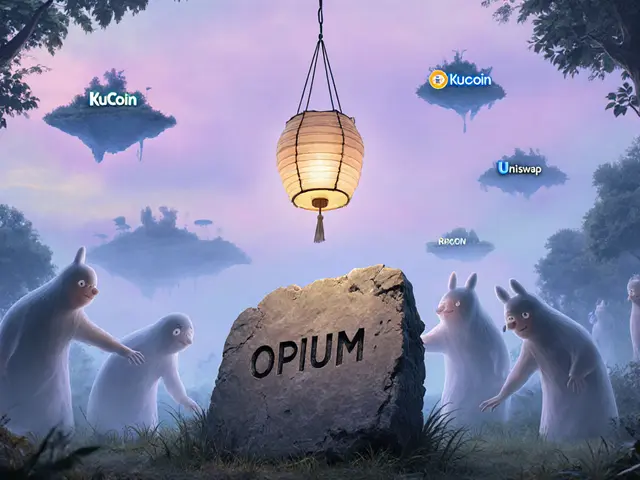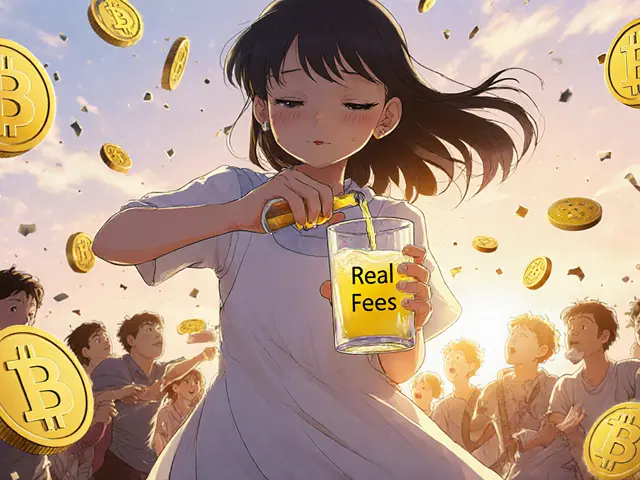ATOMARS Trading Fee Calculator
Calculate Your Trading Fee
See how much you'll pay in fees on ATOMARS compared to other exchanges.
Your Trading Fees
ATOMARS
Flat 0.20% fee
$0.00
Compare to Other Exchanges
0.10% - 0.20% (maker-taker)
0.60% flat
0.16% - 0.26% tiered
0.20% flat
Note: Fees shown are for standard spot trades. Binance fees vary based on maker/taker status and trading volume.
ATOMARS Crypto Exchange is a digital trading platform that aims to give crypto enthusiasts a straightforward way to buy, sell, and swap coins through both desktop and mobile interfaces. Launched sometime before 2023 and operating under the domain atomars.us.com, the exchange markets itself as a low‑fee option with a flat 0.20% trading charge. This review breaks down what you’ll actually experience on ATOMARS, from fee structures to security claims, and compares it to the heavyweights like Binance and Coinbase.
Fee Structure - What You Pay per Trade
Most traders start by looking at fees because they directly affect profit margins. ATOMARS keeps it simple: every trade, whether you’re buying Bitcoin or a brand‑new altcoin, incurs a 0.20% flat fee. There are no maker‑taker tiers, no hidden withdrawal costs mentioned on the public pages, and no premium‑account discounts. For a $10,000 trade, you’ll lose $20 in fees.
Here’s how that stacks up against three well‑known rivals:
| Exchange | Fee Model | Typical Fee % |
|---|---|---|
| ATOMARS Crypto Exchange | Flat | 0.20% |
| Binance | Maker‑taker tiered | 0.10% - 0.20% |
| Coinbase | Flat (standard) | 0.60% |
| Kraken | Tiered | 0.16% - 0.26% |
In raw numbers, ATOMARS sits between Binance’s best‑case 0.10% and Coinbase’s 0.60%. If you trade large volumes, Binance’s tiered system can beat the flat 0.20% fee, but for casual traders the simplicity of ATOMARS is attractive.
Security Claims - How Safe Is Your Money?
Security is the elephant in every crypto‑exchange conversation. ATOMARS’ public documents, notably its Privacy Portal, promise “robust measures to protect your data from loss, misuse, or unauthorized access.” However, the platform stops short of publishing a technical whitepaper, encryption standards, or cold‑storage ratios.
What does the fine print say? The Terms of Service (Sept 15 2023) place a lot of responsibility on users: “users are solely responsible for taking necessary security measures to protect the security of your Collateral Account and personal information.” This mirrors the self‑custody model many smaller exchanges adopt.
Industry experts such as Kudelski Security stress that most breaches arise from weak authentication or compromised web interfaces, not the blockchain itself. Since ATOMARS does not disclose multi‑factor authentication (MFA) defaults, hardware‑wallet integration, or cold‑storage percentages, it’s hard to benchmark against exchanges that publish such details (e.g., Gemini or Coinbase).
In short, the exchange promises basic protection, but the lack of transparent security architecture makes it a riskier choice for large‑scale holders.
Platform & Usability - Desktop and Mobile Experience
Users on Revain.org consistently mention that ATOMARS offers both a desktop web UI and a mobile app. The design is clean, with a typical order‑book view, charting, and quick‑swap buttons. However, the platform does not provide advanced charting tools (e.g., multiple indicators, drawing tools) that power traders expect from Binance or Kraken.
Learning curve appears shallow: new users can create an account, verify identity (KYC) in under 15 minutes, and start trading. That said, the help center is sparse; there are no extensive tutorials, webinars, or a knowledge base comparable to Binance Academy’s 500+ articles.
Customer support seems limited to email and a basic ticket system. The site does not list a live‑chat option, which can be a drawback during urgent market moves.

Coin Listings & Liquidity - What Can You Trade?
ATOMARS markets itself as “new coin friendly.” Reviewers note that the exchange frequently adds emerging altcoins that larger platforms delay. This can be appealing for traders chasing early‑stage projects.
Liquidity, however, is a different story. The exchange does not publish 24‑hour volume, order‑book depth, or market‑making partnerships. In practice, thin books have been reported for lower‑cap tokens, resulting in slippage. For high‑volume pairs like BTC/USDT, the platform appears to route orders through external liquidity providers, but the exact mechanism is undisclosed.
If you need deep liquidity for large trades, you’ll likely find more reliable execution on Binance or Coinbase.
Regulatory Footprint - Licenses and Compliance
Regulatory clarity is a growing concern for crypto platforms. ATOMARS does not display any money‑transmitter licenses, no FinCEN registration, and no jurisdictional disclosures on its website. Compare this with Bitstamp, which openly lists 26 regulatory licences, or Coinbase, which files regular SEC reports.
In regions tightening crypto oversight (e.g., the United States, EU), the lack of visible compliance could limit ATOMARS’ ability to onboard institutional users or offer fiat on‑ramps.

Strengths, Weaknesses & Who Should Consider ATOMARS
- Strengths
- Straightforward 0.20% flat fee - easy to calculate.
- Mobile app available for on‑the‑go trading.
- Frequent listings of new, low‑cap tokens.
- Weaknesses
- Limited transparency on security architecture and cold‑storage.
- No published regulatory licences or compliance reports.
- Thin liquidity for many assets, leading to slippage.
- Sparse educational resources and customer‑support channels.
- Best for
- Retail traders who prioritize simplicity over advanced tools.
- Users interested in experimenting with newly listed altcoins.
- Not ideal for
- High‑volume traders needing deep order books.
- Institutions or users who require proven regulatory compliance.
- Anyone storing large sums without extra security guarantees.
Verdict - Is ATOMARS Worth Your Time?
ATOMARS fills a niche: a low‑fee, mobile‑first exchange that quickly adds new tokens. If you’re a hobbyist looking to dabble with the latest projects and don’t need heavyweight charting or institutional‑grade security, the platform can be an affordable sandbox.
However, the lack of clear security disclosures, regulatory licensing, and deep liquidity means you should approach it with caution. Treat it as a secondary account for small‑scale experiments, not your primary vault for large holdings.
Quick FAQs
What is the trading fee on ATOMARS?
ATOMARS charges a flat 0.20% fee on every spot trade, with no maker‑taker distinction.
Does ATOMARS offer fiat deposits?
Public information does not list any fiat‑on‑ramp options; the platform appears to be crypto‑only.
How secure is the exchange?
ATOMARS claims robust data protection, but it does not publish details on encryption, multi‑factor authentication, or cold‑storage percentages, so users must add their own security layers.
Can I trade on ATOMARS via a mobile app?
Yes, the exchange provides a mobile app for both iOS and Android, allowing you to place orders, view balances, and check market data on the go.
Is ATOMARS regulated?
The exchange does not publicly display any regulatory licenses or compliance certificates, making its regulatory status unclear.






Stephanie Alya
October 24, 2025 AT 09:43 AMFlat 0.20% fee? Groundbreaking. 🙄
Manish Gupta
October 30, 2025 AT 04:36 AMThe platform mentions basic data protection, but it never clarifies whether multi‑factor authentication is enabled by default :) This omission can leave accounts vulnerable to phishing attacks, especially when users rely solely on passwords. Implementing hardware‑wallet support would dramatically improve security posture, yet ATOMARS provides no clear integration path.
Gabrielle Loeser
November 4, 2025 AT 23:29 PMThe regulatory landscape for crypto exchanges has become increasingly intricate over the past few years.
In jurisdictions such as the United States and the European Union, operators are expected to obtain specific money‑transmitter licenses and comply with anti‑money‑laundering (AML) reporting standards.
The ATOMARS platform, as described in the review, does not publish any such licensure information on its website.
This omission makes it difficult for potential users to assess whether the exchange meets the baseline compliance requirements enforced by regulators.
Moreover, the lack of a visible FinCEN registration number raises concerns for U.S. residents who must adhere to strict reporting obligations.
Institutional investors typically demand third‑party audits and attestations, which serve as a safeguard against operational and custodial risks.
Without publicly available audit reports, ATOMARS cannot demonstrate the same level of transparency that competitors like Coinbase or Kraken provide.
The exchange’s Terms of Service place a heavy burden on users to secure their own accounts, a model that is acceptable for hobbyist traders but not for entities subject to fiduciary duties.
From a legal standpoint, the absence of disclosed regulatory oversight could also expose ATOMARS to enforcement actions should authorities decide to scrutinize unlicensed crypto service providers.
Users operating in regions with stringent licensing regimes may find their accounts frozen or terminated without recourse.
Additionally, the lack of a clear jurisdictional framework complicates tax reporting for individuals and businesses alike.
In practice, many exchanges mitigate this risk by partnering with licensed custodians, thereby offloading part of the compliance burden.
ATOMARS does not appear to have such partnerships, which further amplifies the regulatory uncertainty.
Prospective traders should therefore conduct thorough due diligence, possibly consulting legal counsel before committing significant capital to the platform.
In summary, while the exchange offers attractive fee simplicity, its opaque regulatory posture represents a material risk factor for users who prioritize compliance and legal certainty.
Abby Gonzales Hoffman
November 10, 2025 AT 18:23 PMGreat points on the compliance side! Even if the fee structure is simple, the hidden regulatory risks can bite you when you least expect it. If you’re just dabbling, treat ATOMARS as a sandbox, but never store your life savings there. Always keep a backup on a hardware wallet and consider moving larger positions to a fully regulated exchange.
Prabhleen Bhatti
November 16, 2025 AT 13:16 PMAlright folks, let’s dissect the fee paradigm – the 0.20% flat rate is unquestionably *transparent*, yet it borders on the *mediocre* when juxtaposed against tiered giants like Binance that can dip below 0.10% for high‑volume leviathans!; the *simplicity* of a single‑digit charge may entice retail users, but seasoned market‑makers will inevitably gravitate towards platforms offering volume‑based rebates.
Security-wise, the absence of explicit MFA deployment and cold‑storage ratios is not merely a *gap*; it’s a glaring red flag that could erode user confidence! Moreover, the Terms of Service's heavy reliance on user‑side security measures effectively transfers custodial risk onto the end‑consumer, a practice that many regulators frown upon.
Liquidity paucity for nascent altcoins further compounds the conundrum – thin order books translate to slippage, especially during volatile market swings.
Regulatory opacity, too, cannot be dismissed: no disclosed licenses mean uncertain jurisdictional oversight, which may affect fiat on‑ramps and AML compliance.
In sum, ATOMARS is a **double‑edged sword**: appealing for low‑fee, experimental trades, yet fraught with systemic risk factors that could jeopardize substantial holdings.